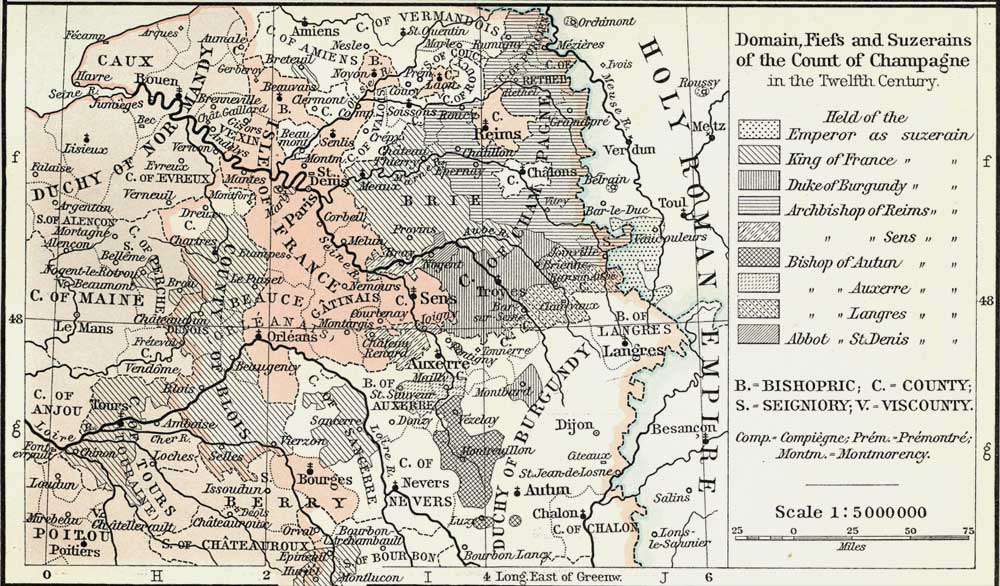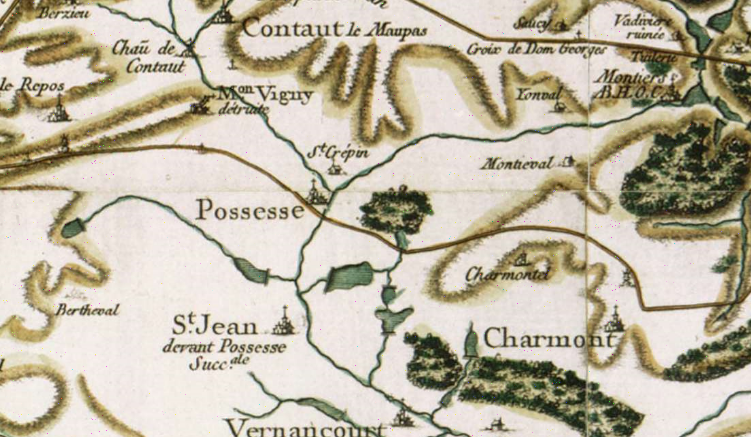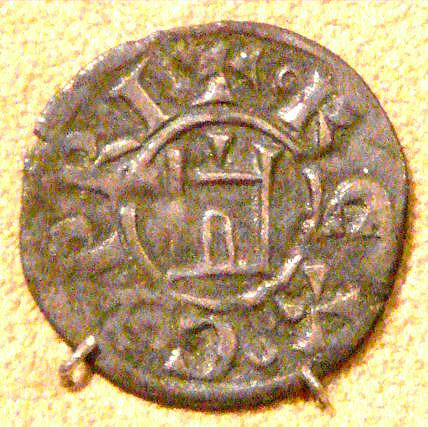|
Philip II (bishop Of Châlons)
Philip II (died 12 April 1237), called Philippe de Méréville or Philippe de Nemours, was the bishop of Châlons from 1228 until his death. He was a member of the nobility of the Île-de-France, and was a priest in Paris before coming to Châlons. As bishop, he was a consistent ally of Count Theobald IV of Champagne, in whose county his diocese lay. Early life Philip was the second son of Orson I, lord of Méréville, Essonne, Méréville, and his wife Liesse. Orson himself was the son of Walter I, lord of Nemours. Philip's elder brother, Orson II, inherited Méréville while he was destined for the church. Two other brothers, Guillaume and Galeran, are barely mentioned and probably died young.Émile-Louis Richemond, ''Recherches généalogiques sur la famille des seigneurs de Nemours du 12e au 15e siècle'', vol. 2 (Fontainebleau: Maurice Bourges, 1908), pp. 23–28. Philip became a canon at Notre Dame de Paris during the episcopate of his uncle, Pierre de Nemours (1208–19). Hi ... [...More Info...] [...Related Items...] OR: [Wikipedia] [Google] [Baidu] |
Seal Of Bishop Philip II Of Châlons
Seal may refer to any of the following: Common uses * Pinniped, a diverse group of semi-aquatic marine mammals, many of which are commonly called seals, particularly: ** Earless seal, or "true seal" ** Fur seal * Seal (emblem), a device to impress an emblem, used as a means of authentication, on paper, wax, clay or another medium (the impression is also called a seal) * Seal (mechanical), a device which helps prevent leakage, contain pressure, or exclude contamination where two systems join Arts, entertainment and media * Seal (1991 album), ''Seal'' (1991 album), by Seal * Seal (1994 album), ''Seal'' (1994 album), sometimes referred to as ''Seal II'', by Seal * ''Seal IV'', a 2003 album by Seal * ''Seal Online'', a 2003 massively multiplayer online role-playing game Law * Seal (contract law), a legal formality for contracts and other instruments * Seal (East Asia), a stamp used in East Asia as a form of a signature * Record sealing Military * ''Fairey Seal'', a 1930s British ... [...More Info...] [...Related Items...] OR: [Wikipedia] [Google] [Baidu] |
Henri De Dreux
Henri de Dreux (1193–1240) was Archbishop of Reims from 1227 to 1240. He is commemorated by a window in Reims Cathedral. He was an active builder, but his local taxation provoked a revolt in 1233. He was a son of Robert II of DreuxA History of the Crusades, Vol. 2, ed. Kenneth M. Setton, Robert Lee Wolff and Harry W. Hazard, (University of Wisconsin Press, 1969), 836. and Yolande de Coucy. Ancestry Notes External links Stained glass window of Henri in his cathedral {{DEFAULTSORT:Dreux, Henri De 1193 births 1240 deaths Archbishops of Reims 13th-century Roman Catholic archbishops in France 13th-century peers of France ... [...More Info...] [...Related Items...] OR: [Wikipedia] [Google] [Baidu] |
Renard II Of Dampierre-en-Astenois
Renard II, also spelled Reynald, Raynald, Rainard or Renaud (born 1170s, died 1234), was the count, or lord, of Dampierre-le-Château in the Astenois. His lordship lay partly within the Holy Roman Empire, but he was also a direct vassal of the Count of Champagne. Renard took part in the Fourth Crusade, but did not join the siege of Constantinople. He was captured in the Holy Land by the emir of Aleppo, and remained in prison for twenty-eight years until he was ransomed. Family and church Renard was a son of Renard I (died 1190/1) and Euphemia (married by 1163). He married Helvide (or Héloïse) shortly after the death of her first husband, Henry, castellan of Vitry, in 1190. She bore the title ''castellana'', while Renard administered the castellany on behalf of her young son Hugh. In 1191, Renard, bearing the titles count of Dampierre and castellan of Vitry, made a donation to the Templars of Vitry. He continued to administer Vitry on behalf of Hugh until the latter's early de ... [...More Info...] [...Related Items...] OR: [Wikipedia] [Google] [Baidu] |
Abbey Of Monthiers-en-Argonne
The Abbey of Monthiers-en-Argonne (also spelled Montiers-en-Argonne, from Latin ''Monasterium in Argona'', "monastery in the Argonne") was a Cistercian monastery located in Possesse in the diocese of Châlons-sur-Marne in the County of Champagne. A daughter house of Trois-Fontaines and of the lineage of Clairvaux, it was dedicated to Saints Nicholas and Mary (Notre-Dame). According to Leopold Janauschek, its order number was 194. It was founded at the site called "Vieux Montiers" (Old Monastery) by its first abbot, Eustache, around 1135. Originally a house of Augustinian canons, it adopted the Cistercian rule on 30 May 1144. The monastery was moved to its final location, where its ruins are still found, around 1155. Eustache was assisted by a co-abbot, Gervais, and together they greatly expanded the abbey's temporalities. Towards the end of the century, the abbey was embroiled in controversy over land with the lords of Possesse and Dampierre-en-Astenois, especially Lord Renar ... [...More Info...] [...Related Items...] OR: [Wikipedia] [Google] [Baidu] |
Saint-Antoine-des-Champs
Saint-Antoine-des-Champs Abbey was a convent in what is now the 12th arrondissement of Paris. The faubourg Saint-Antoine developed around it. It later became the hôpital Saint-Antoine. History Middle Ages Renaissance and Enlightenment Conversion to a hospital List of abbesses ''Source : Calendrier historique et chronologique de l'Église de Paris, par A.M. Le Fèvre prêtre de Paris et bachelier en théologie, 1747'' Temporal lands References {{Coord, 48, 50, 56, N, 2, 22, 57, E, region:FR_type:landmark_source:kolossus-cswiki, display=title Cistercian nunneries in France Roman Catholic churches in the 12th arrondissement of Paris Christian monasteries in Paris ... [...More Info...] [...Related Items...] OR: [Wikipedia] [Google] [Baidu] |
Kingdom Of Cyprus
The Kingdom of Cyprus (french: Royaume de Chypre, la, Regnum Cypri) was a state that existed between 1192 and 1489. It was ruled by the French House of Lusignan. It comprised not only the island of Cyprus, but it also had a foothold on the Anatolian mainland: Antalya between 1361 and 1373, and Corycus between 1361 and 1448. History Third Crusade Richard confiscated the property of those Cypriots who had fought against him. He also imposed a 50% capital levy on the island in return for confirming its laws and customs. He also ordered Cypriot men to shave their beards. There was a rebellion led by a relative of Isaac's, but it was crushed by Robert of Thornham, who hanged the leader. Richard rebuked Robert for this execution, since executing a man who claimed to be king was an affront to royal dignity. Some details of the brief English period on Cyprus can be found in the '' Chronicle of Meaux Abbey'', possibly derived from Robert of Thornham, who had a relationship with the a ... [...More Info...] [...Related Items...] OR: [Wikipedia] [Google] [Baidu] |
Alice Of Champagne
Alice of Champagne (french: Alix; 1193 – 1246) was the queen consort of Cyprus from 1210 to 1218, regent of Cyprus from 1218 to 1223, and of Jerusalem from 1243 to 1246. She was the eldest daughter of Queen Isabella I of Jerusalem and Count Henry II of Champagne. In 1210, Alice married her step-brother King Hugh I of Cyprus, receiving the County of Jaffa as dowry. After her husband's death in 1218, she assumed the regency for their infant son, King Henry I. In time, she began seeking contacts within her father's counties in France to bolster her claim to Champagne and Brie against her cousin, Theobald IV. However, the kings of France never acknowledged her claim. After a dispute with Philip of Ibelin, ''bailli'' of Cyprus in 1223, she left the island. She married Bohemond, heir apparent to the Principality of Antioch and the County of Tripoli, but their marriage was annulled because of kinship. She laid claim to the Kingdom of Jerusalem against the infant Conrad (the son of ... [...More Info...] [...Related Items...] OR: [Wikipedia] [Google] [Baidu] |
County Of Champagne
The County of Champagne ( la, Comitatus Campaniensis; fro, Conté de Champaigne), or County of Champagne and Brie, was a historic territory and feudal principality in France descended from the early medieval kingdom of Austrasia. The county became part of the crown lands due to the marriage of Queen Joan I of Navarre, who was the countess of Champagne, and King Philip IV of France. History The county reached its peak as one of the richest and strongest of the French principalities during the rule of Henry I. The court of Champagne became a renowned literary center, and the county hosted the Champagne fairs at their height. The countship passed to the French crown in 1314, forming the province of Champagne. See also * Count of Champagne The count of Champagne was the ruler of the County of Champagne from 950 to 1316. Champagne evolved from the County of Troyes in the late eleventh century and Hugh I was the first to officially use the title count of Champagne. Count The ... [...More Info...] [...Related Items...] OR: [Wikipedia] [Google] [Baidu] |
Louis IX
Louis IX (25 April 1214 – 25 August 1270), commonly known as Saint Louis or Louis the Saint, was King of France from 1226 to 1270, and the most illustrious of the Direct Capetians. He was crowned in Reims at the age of 12, following the death of his father Louis VIII. His mother, Blanche of Castile, ruled the kingdom as regent until he reached maturity, and then remained his valued adviser until her death. During Louis' childhood, Blanche dealt with the opposition of rebellious vassals and secured Capetian success in the Albigensian Crusade, which had started 20 years earlier. As an adult, Louis IX faced recurring conflicts with some of his realm's most powerful nobles, such as Hugh X of Lusignan and Peter of Dreux. Simultaneously, Henry III of England attempted to restore the Angevin continental possessions, but was promptly routed at the Battle of Taillebourg. Louis annexed several provinces, notably parts of Aquitaine, Maine and Provence. Louis IX enjoyed immense pre ... [...More Info...] [...Related Items...] OR: [Wikipedia] [Google] [Baidu] |
Blanche Of Castile
Blanche of Castile ( es, Blanca de Castilla; 4 March 1188 – 27 November 1252) was Queen of France by marriage to Louis VIII. She acted as regent twice during the reign of her son, Louis IX: during his minority from 1226 until 1234, and during his absence from 1248 until 1252. She was born in Palencia, Spain, in 1188, the third daughter of Alfonso VIII, King of Castile, and Eleanor of England, sister of King Richard I of England and King John of England. Early life In her youth, she visited the Abbey of Santa María la Real de Las Huelgas, founded by her parents, several times. In consequence of the Treaty of Le Goulet between Philip Augustus and John of England, Blanche's sister, Urraca, was betrothed to Philip's son, Louis. After meeting the two sisters, their grandmother Eleanor of Aquitaine (who had been a queen consort of France herself) judged that Blanche's personality was more fit to fulfil the role. In the spring of 1200, Eleanor crossed the Pyrenees with her and br ... [...More Info...] [...Related Items...] OR: [Wikipedia] [Google] [Baidu] |
Bishop Of Verdun
The Bishopric of Verdun was a state of the Holy Roman Empire. It was located at the western edge of the Empire and was bordered by France, the Duchy of Luxembourg, and the Duchy of Bar. Some time in the late 990s, the suzerainty of the County of Verdun passed from Herman of Ename of the House of Ardenne–Verdun to the Bishopric of Verdun. History This fief also included the advowson of the church of Verdun over its possessions along the river Moselle. According to a chronist's report, written around the year 900, the Merovingian king Childebert II (575–596) came to visit Verdun. There was not enough wine to serve the monarch and the Bishop Agericus was very embarrassed. However God rewarded him for his good deeds and miraculously increased the amount of wine. The king presented Agericus of Verdun with the Schloss Veldenz as a fief of Verdun "because of the wine". Around 1156 Frederick Barbarossa confirmed the holding by Bishop Albert I of Verdun of the castle together with t ... [...More Info...] [...Related Items...] OR: [Wikipedia] [Google] [Baidu] |
Orléans Cathedral
Orléans Cathedral ( French: ''Basilique Cathédrale Sainte-Croix d'Orléans'') is a Roman Catholic church located in the city of Orléans, France. The cathedral is the seat of the Bishop of Orléans. It was originally built from 1278 to 1329. It was partially destroyed in 1568 by the Huguenots during the French Wars of Religion, but was rebuilt between 1601 and 1829. The edifice is in the Gothic architectural style. During the Siege of Orléans, the cathedral was visited frequently by Joan of Arc. The cathedral's stained glass windows now depict the story of Joan's actions that contributed to the lifting of the siege. Burials *John Stewart of Darnley See also *List of Gothic Cathedrals in Europe This is a list of gothic cathedrals in Europe that are active Christian cathedrals (the seats of bishops), but also includes former cathedrals and churches built in the style of cathedrals, that are significant for their Gothic style of architecture ... References *“Orléans Cathed ... [...More Info...] [...Related Items...] OR: [Wikipedia] [Google] [Baidu] |
_Cathédrale_Baie_118-3.jpg)



